Haynes 25 Sheets is a cobalt-based alloy with exceptional formability and high-temperature characteristics. Haynes 25 Sheets have a 100-hour stress-rupture strength of 7000 psi at 1800°F. To 1900°F, the alloy is resistant to oxidation and carburization.
Principle Features of Haynes 25
Corrosion Resistance
Haynes 25 Sheets has proven to be extremely resistant to the hot corrosive atmospheres experienced in some jet engine operations. The oxidation resistance is adequate for intermittent service up to 1600°F and continuous service up to 2000°F.
Haynes 25 Sheets is very resistant to scale and oxidation at high temperatures, having particularly good properties in severely oxidizing environments.
At certain concentrations and temperatures, this material also has exceptional resistance to chemical oxidizing agents and exceptional resilience to hydrochloric and nitric acids. The resistance to salt spray corrosion is excellent.
Heat Treatment
Heat-Treated Solution for Best Properties
Most wrought goods are shipped in the solution heat-treated form for optimal characteristics. This alloy is typically solution heat treated at temperatures ranging from 2150 to 2250°F before being quickly air-cooled or water-quenched. Sheets 0.025" thick or less are solution heat treated at 2150°F, rapid air cooled or water quenched; sheets 0.026" and greater are solution heat treated at 2200°F, rapid air cooled or water quenched; plates are solution heat treated at 2200°F, water quenched; and bars are solution heat treated at 2250°F, water quenched.
Cold Work and Aging Improve Room and Elevated Temperature Properties
When done correctly, cold working and aging increase both the room and raised temperature tensile strength of Haynes 25 sheet. Moderate levels of cold work will raise creep strength to 1800°F and stress rupture strength to 1500°F. Aging has no discernible advantages. Strain aging, at temperatures ranging from 700 to 1100°F, enhances creep and rupture strength below 1300°F.
Workability
Machinability
Haynes 25 (L-605) can be machined using standard processes; however, cobalt grades of high-speed steel or carbide tools paired with stiff machine configurations are suggested.
The austenitic stainless steels are easier to process than Haynes 25 (L-605) (i.e. Types 302, 304, 321, and 347 stainless). Lower feeds, speeds, and depths of cut are often recommended. Machining is complicated by a high work hardening rate, heat generation during cutting, and high shear strength.
Welding
Shielded metal-arc, gas tungsten-arc (TIG), and gas metal-arc (MIG) welding processes can be used to join Haynes 25. Submerged-arc welding is not advised because of the high heat input to the base metal and the sluggish cooling of the weld. These elements can reduce weld ductility and induce cracking.
Cleaning
Before welding, the joint surface and surrounding region should be completely cleaned down to the shining metal. Scrubbing with trichloroethylene or another suitable solvent should remove all grease, oil, crayon marks, and other foreign debris. Before welding, the surface should be well-cleaned.
Application Of Haynes Industries
- Petrochemical Industries
- Marine Industries
- Food Processing Industries
- Oil & Gas Industries



